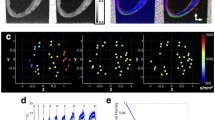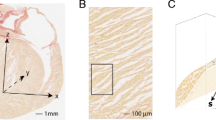Abstract
Imaging of cardiac structure is thus essential for understanding both electrical propagation and efficient contraction in human models. The processing pipeline of diffusion tensor imaging (DTI) and structure tensor imaging (STI) is described and the first ex vivo demonstration of this approach in a human heart is provided at 9.4T.
A human heart was fixed in formaldehyde with gadolinium then immersed in Fomblin. MRI acquisitions were performed at 9.4T/30 cm with a 7 elements transmit/receive coil. 3D spin-echo DTI at 600 × 600 × 600 µm3 and 3D FLASH echo image at 150 × 150 × 150 µm3 were produced. Tensor extraction and analysis were performed on both volumes.
3D gradient echo at 150 × 150 × 150 µm3 allows direct visualization of detailed structure of LV. Abrupt change in sheetlet orientation is observed in the LV and is confirmed with STI. The DTI helix angle has a smooth transmural change from endocardium to epicardium. Both the helix and transverse angles are shown to be similar between DTI and STI. The sheetlet organization between both acquisitions displays the same pattern even though local angle differences are demonstrated.
In conclusion, these preliminary results are promising for investigating 3D structural characterization of normal/pathologic cardiac organization in human. It opens new perspectives to better understand the links between structural remodeling and electrical disorders of the heart.
Access this chapter
Tax calculation will be finalised at checkout
Purchases are for personal use only
Similar content being viewed by others
References
Hooks, D.A., Trew, M.L., Caldwell, B.J., Sands, G.B., LeGrice, I.J., Smaill, B.H.: Laminar arrangement of ventricular myocytes influences electrical behavior of the heart. Circ. Res. 101(10), e103–e112 (2007)
Streeter Jr., D.D., Spotnitz, H.M., Patel, D.P., Ross Jr., J., Sonnenblick, E.H.: Fiber orientation in the canine left ventricle during diastole and systole. Circ. Res. 24(3), 339–347 (1969)
Rohmer, D., Sitek, A., Gullberg, G.T.: Reconstruction and Visualization of Fiber and Sheet Structure with Regularized Tensor Diffusion MRI in the Human Heart, Lawrence Berkeley National Laboratory (2006)
Gilbert, S.H., Benson, A.P., Li, P., Holden, A.V.: Regional localization of left ventricular sheet structure: integration with current models of cardiac fiber, sheet and band structure. Eur. J. Cardiothorac. Surg. 32(2), 231–249 (2007)
LeGrice, I.J., Smaill, B.H., Chai, L.Z., Edgar, S.G., Gavin, J.B., Hunter, P.J.: Laminar structure of the heart: ventricular myocyte arrangement and connective tissue architecture in the dog. Am. J. Physiol. 269(2 Pt 2), H571–H582 (1995)
Toussaint, N., Stoeck, C.T., Schaeffter, T., Kozerke, S., Sermesant, M., Batchelor, P.G.: In vivo human cardiac fiber architecture estimation using shape-based diffusion tensor processing. Med. Image Anal. 17(8), 1243–1255 (2013)
Nielles-Vallespin, S., et al.: Assessment of myocardial microstructural dynamics by in vivo diffusion tensor cardiac magnetic resonance. J. Am. Coll. Cardiol. 69(6), 661–676 (2017)
Holmes, A.A., Scollan, D.F., Winslow, R.L.: Direct histological validation of diffusion tensor MRI in formaldehyde-fixed myocardium. Magn. Reson. Med. 44(1), 157–161 (2000)
Teh, I., et al.: Resolving fine cardiac structures in rats with high-resolution diffusion tensor imaging. Sci. Rep. 6, 30573 (2016)
Helm, P.A., Tseng, H.J., Younes, L., McVeigh, E.R., Winslow, R.L.: Ex vivo 3D diffusion tensor imaging and quantification of cardiac laminar structure. Magn. Reson. Med. 54(4), 850–859 (2005)
Healy, L.J., Jiang, Y., Hsu, E.W.: Quantitative comparison of myocardial fiber structure between mice, rabbit, and sheep using diffusion tensor cardiovascular magnetic resonance. J. Cardiovasc. Magn. Reson. 13, 74 (2011)
Köhler, S., Hiller, K.H., Waller, C., Jakob, P.M., Bauer, W.R., Haase, A.: Visualization of myocardial microstructure using high-resolution T *2 imaging at high magnetic field. Magn. Reson. Med. 49(2), 371–375 (2003)
Gilbert, S.H., et al.: Visualization and quantification of whole rat heart laminar structure using high-spatial resolution contrast-enhanced MRI. Am. J. Physiol. Heart Circ. Physiol. 302(1), H287–H298 (2012)
Bernus, O., et al.: Comparison of diffusion tensor imaging by cardiovascular magnetic resonance and gadolinium-enhanced 3D image intensity approaches to investigation of structural anisotropy in explanted rat hearts. J. Cardiovasc. Magn. Reson. 17, 31 (2015)
Sacolick, L.I., Wiesinger, F., Hancu, I., Vogel, M.W.: B1 mapping by Bloch-Siegert shift. Magn. Reson. Med. 63(5), 1315–1322 (2010)
Tustison, N.J., et al.: N4ITK: improved N3 bias correction. IEEE Trans. Med. Imaging 29(6), 1310–1320 (2010)
Gilbert, S.H., Smaill, B.H., Walton, R.D., Trew, M.L., Bernus, O.: DT-MRI measurement of myolaminar structure: accuracy and sensitivity to time post-fixation, b-value and number of directions. In: Conference Proceedings of IEEE Engineering in Medicine and Biology Society, pp. 699–702 (2013)
Gilbert, S., Trew, M., Smaill, B., Radjenovic, A., Bernus, O.: Measurement of myocardial structure: 3D structure tensor analysis of high resolution MRI quantitatively compared to DT-MRI. In: Camara, O., Mansi, T., Pop, M., Rhode, K., Sermesant, M., Young, A. (eds.) STACOM 2012. LNCS, vol. 7746, pp. 207–214. Springer, Heidelberg (2013). https://doi.org/10.1007/978-3-642-36961-2_24
Fedorov, A., et al.: 3D slicer as an image computing platform for the quantitative imaging network. Magn. Reson. Imaging 30(9), 1323–1341 (2012)
Cerqueira, M.D., et al.: Standardized myocardial segmentation and nomenclature for tomographic imaging of the heart. A statement for healthcare professionals from the Cardiac Imaging Committee of the Council on Clinical Cardiology of the American Heart Association. Circulation 105, 539–542 (2002)
Author information
Authors and Affiliations
Corresponding author
Editor information
Editors and Affiliations
Rights and permissions
Copyright information
© 2019 Springer Nature Switzerland AG
About this paper
Cite this paper
Haliot, K. et al. (2019). 3D High Resolution Imaging of Human Heart for Visualization of the Cardiac Structure. In: Coudière, Y., Ozenne, V., Vigmond, E., Zemzemi, N. (eds) Functional Imaging and Modeling of the Heart. FIMH 2019. Lecture Notes in Computer Science(), vol 11504. Springer, Cham. https://doi.org/10.1007/978-3-030-21949-9_22
Download citation
DOI: https://doi.org/10.1007/978-3-030-21949-9_22
Published:
Publisher Name: Springer, Cham
Print ISBN: 978-3-030-21948-2
Online ISBN: 978-3-030-21949-9
eBook Packages: Computer ScienceComputer Science (R0)




